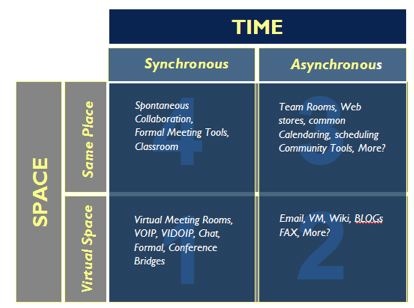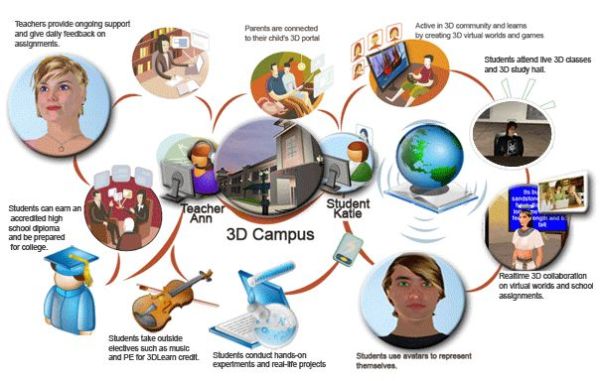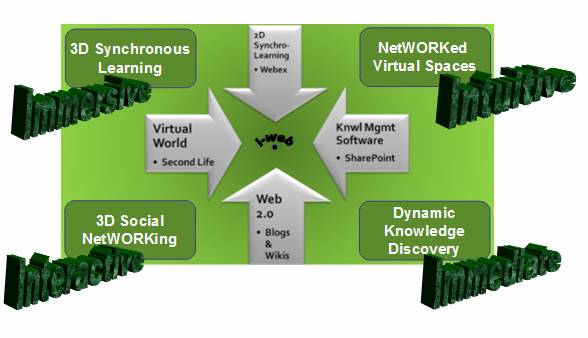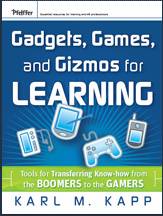Every spare moment this week has been devoted to investigating this question.
I come to this question having spent much time in the world of Electronic Performance Support (EPSS) and Workflow Learning and my perspective is informed by traditional Human Performance Technology (HPT) theory.
I can’t move on from that reference without sadly recognizing the passing of Geary Rummler. He truly was a giant in the field and his works were very influential on my own perspective and practice. RIP Geary.
OK, Investigating this question takes the tension of topic/content/formal versus task/context/informal we’ve been wrestling with for some time in learning/KM to the next level. It forces us to examine how Web 2.0 impacts the enterprise of the future as we migrate from database centric stocks of tagged explicit knowledge to social computing enabled flows of digitally enabled people with ability to find each other to innovate and problem solve in real time. In short, I am in a hurry to figure out the Enterprise (or Eduprise in my context) 2.0 IT infrastructure looks like…because we need to BUILD IT here at Fuqua by August of next year ; )
Mc Kinsey’s “Building the Web 2.0 Enterprise” Global Survey Results found that companies are using Web 2.0 technologies more frequently for INTERNAL purposes. Similar to its Web 1.0 cousin, it looks like the B2C period of inflated expectations has passed and we are moving to focus on pragmatic, internal applications with a focus on efficiency. Within the internal use category, the top six enterprise application areas were:
Managing Knowledge
Fostering Collaboration across the Community
Enhancing Company Culture
Training
Developing Products or Services
Internal Recruiting
Interestingly, as I look at analyst reports on the trends and lists of internal application areas where virtual worlds will have impact, the list is strikingly similar to those outlined above for Web 2.0.
Steve Prentice of Gartner has long maintained that the Business to Consumer Marketing focus of Virtual Worlds will retreat to the Enterprise and seek safe haven from the treacherous waters of an increasingly unpredictable market in the safe harbor of productivity focused internal applications of Collaboration and Learning.
Thinkbalm’s Erica and Sam Driver in their recent Immersive Internet report break enterprise applications into 8 High Impact use cases. They further hypothesize that these 8 use cases will array across three phases moving from Cost Savings, through Harnessing Unexpected Business Value, ultimately leading to Business Transformation.
Their time chart for how these enterprise applications array across the phases and time is shown below:

So what gives? If BOTH Web 2.0 and the Immersive Internet/3Di forecasts promise to have enterprise application in the areas of collaboration and learning, it seems to me that these emerging applications can only be a thoughtful and nuanced Mash Up of both. The trick here is figuring out what mix of what technologies for what outcomes.
Justin Bovington and his team at Rivers Run Red appear to have spotted this early. Here is a nice video that explains their Immersive Workspaces 2.0 offering developed with the Lindens:
From this overview, it is clear that much thought must go into the orchestration and coordination of digitally mediated presence, connection, conversation, sharing, presentation, co-creation, discovery etc…in order to enable a seamless 2D/3Di experience that allows people to work at a distance with mind-numbing ease.
Here at Fuqua we are right in the thick of prototyping/iterating/co-creating the Uber 2.0 Eduprise Mashup. We not only need to integrate Web 2.0 and 3Di but we also need to plug it into (or more appropriately position on top of) our existing technological infrastructure that enables the orchestration of World Class MBA programs at a distance (i.e. our LMS and LCMS).
In guiding our Itervation (Iterative Innovation that is), there are a few sources that provide direction:
FIRST is the Seven Sensibilities of Virtual worlds mentioned earlier in this blog. Our guiding premise here is to only leverage 3D where it makes a strategic and significant difference. No good doing 3D just for its own sake, much better to apply where it makes a marked and memorable impact on the end-to-end educational experience for our stakeholders.
SECOND, Erica Driver’s work at Forrester in defining the Seven Tenents of the Information Workplace have been very helpful. Here is our slightly modified version:
Context: Today users have to make conscious decisions about when to use which tool to collaborate with others on a document or deliverable. To overcome this issue we need to clearly define what “contextualizes” and what is “contextualized.” Profile/Role, task and Connection Mechanisms will contextualize content and connections in real time around the endeavor at hand. This will lead to a more intuitive and usable immersive workspace that allows users to more rapidly get to the “Doing” rather than dealing with the overhead of planning, co-ordinating and connecting before getting to the “Doing”
Individualized: The user (Prospect, Student, Staff, Faculty, Alum) must be at the center of the design of our next generation learning Collaboration and Learning Intuitive Learning Environment (CLIVE). The technology must adapt to the individual, not the other way around. CLIVE must have both a social/personal and personalized programmatic component. Leveraging our understanding of the Contextualizers (i.e. WHO the user is, HOW they are connected to the environment, WHERE they are in the workspace, and WHAT they are trying to do) allows CLIVE to tune the interface to the individual context and shift the burden of orchestration and coordination of resources required to accomplish a given task from the individual to the environment itself.
Seamless: CLIVE must seamlessly integrate new Web 2.0/3Di service apps with our existing LMS/LCMS infrastructure. It must mask the complexity of back end applications and interfaces with elegant and intuitive simplicity on the front end. People must be able to invoke and act upon the information, contacts and tools they need with minimal effort. We should not burden the cognitive load of users in preparing to do work. Rather, we should provide a “draggy, droppy, clicky” environment that allows them to get on with the REAL work of collaborative co-creation.
A consistent look and feel must be maintained across the various components assembled in the environment even when multiple back end systems are being leveraged. To the user, it should NEVER feel like they are switching back and forth between applications or telescoping up and down within a rigid navigation system to marshal resources to accomplish a task. CLIVE orients the world of content, contacts and connectivity around the user and shrinks the world to surface relevant resources to solve the task at hand.
CLIVE must also accommodate the seamless movement back and forth between structured formal learning and unstructured collaborative peer learning in a way that both approaches are honored and activated where they are most appropriate and where the whole learning experience yields moments of synthesis for the participants that are greater than the sum of the pedagogical/technological parts. CLIVE must continuously strike the balance between structure and serendipity in the service of enriching the learning experience.
Visual: Our mash-up should resonate visually and allow people to quickly grok content and intuit context (i.e. Tags and Social Network Representations in 2D space and avatar interactions with each other and data/models in 3D space). Traditional Web-Based navigation schemes are information-centric and thus challenged in their ability to keep pace with a user’s need to quicky scan, interpret, and act on contextually relevant information. Clearly there is an opportunity to leverage visualizations of meta-data via tag-clouds and social connectedness via Social Networking technologies have relevance here as does the opportunity to leverage the third dimension (avec ou sans avatar) to improve the “grokability” of the environment.
Multimodal: Our system must recognize that, as Kevin Kelly so ably suggests, there is only One Machine and the Web is its OS. We need to strive to be able to accommodate all the devices that connect to the one machine in a seamless way (can we please hurry up with visualization and the cloud?) – Timestamp 3:15 to get to demo.
Quick: Does this need explanation? Wiki is a Hawaiian word for Fast! CLIVE needs to work. CLIVE needs to work without a manual. CLIVE needs to ignite talent opportunity and passion around ideas and endeavors at an an accelerated pace, and CLIVE needs to activate the growing and incredibly talented network that is Fuqua (over 14K strong today) to address the pressing issues of our times. What am I missing, oh yes…..CLIVE needs to work YESTERDAY (OK, not yesterday, but late March at the latest).
The THIRD source of guidance for itervating CLIVE comes from Gartner’s analysis of the Business Impact of Social Computing on Higher Education. In this report, Harris and Lowendahl suggest that, “the incorporation of social software features and integration capabilities with institutional applications will become necessary to accommodate the higher education user expectations, while closing the gap between personal and institutional structures.” They go on to say, “If positioned strategically, social computing can fill a gap between the inflexible structures in place in most higher-education organizations and the chaotic personal structures that have spread across the desktops of both student and faculty.”
So CLIVE must bridge the gap between the existing enterprise infrastructure and the personal chaotic structure that has emerged to compensate for the ridgidiy and inflexibility of that enterprise infrastructure. CLIVE needs to provide an adaptive structure that allows users to CREATE, ORGANIZE, FIND AND INTERACT more intuitively. To do so CLIVE must:
Provide Persistent Presence to allow ongoing openess for participation
Render Content, Contacts and Connectivity that is contextualized to user role/workflow
Organize Content, Contacts and Connectivity to reflect users current use and needs
Encourage natural and serendipitous group formation based on location, activities and interests
Leverage links, tags, ratings and usage to determine relevance, importance and quality
Find content through people links and vise versa
Dynamically update profiles based on content/tags created, involvement in interactions and aggregation of user-generated commentary,co-creation, content, filtering and organization.
The FOURTH area of inspiration for itervating on CLIVE comes from Anderew McAfee’s work on Enterprise 2.0 that I discussed in an earlier post here. Contextualizing his SLATES components to CLIVE comes out something like this:
Search and Serendipitous Discovery trump Interface Navigation/Hierarchy. In fact, just as Thomas Friedman suggest that the world is FLAT. A core design point for our CLIVE is that the interface itself must be FLAT and that the content, contacts and connectivity elements are surfaced within that FLAT interface based on the contextual factors at play.
Links, Tags and Extensions and Signals are the domain of User Generated Commentary, Content, Filtering, Organizing and Distribution that CLIVE must provide. The trick here is that it must work across all the underlying apps that the FLAT interface masks. How do we take all the richness of web-serviced applications, mash them up with existing enterprise platforms and allow the informal serendipity of fortuitous interaction to prevail in a system that is optimized to create a flow state for formal and informal learning and inquiry that rivals that of World of Warcraft?
The very interesting thing about the participatory web approach is that it not only helps others find explicit knowledge but it also exposes the patterns and processes in knowledge work that others use. As McAfee says, these participatory systems make an episode of knowledge work more widely and permanently visible.
This is going to be a fun ride….anyone with any experience, advice, wisdom, counsel, please bring it on. This is new territory to be sure and none of us is as smart as all of us. Ideas and insights PLEASE.












